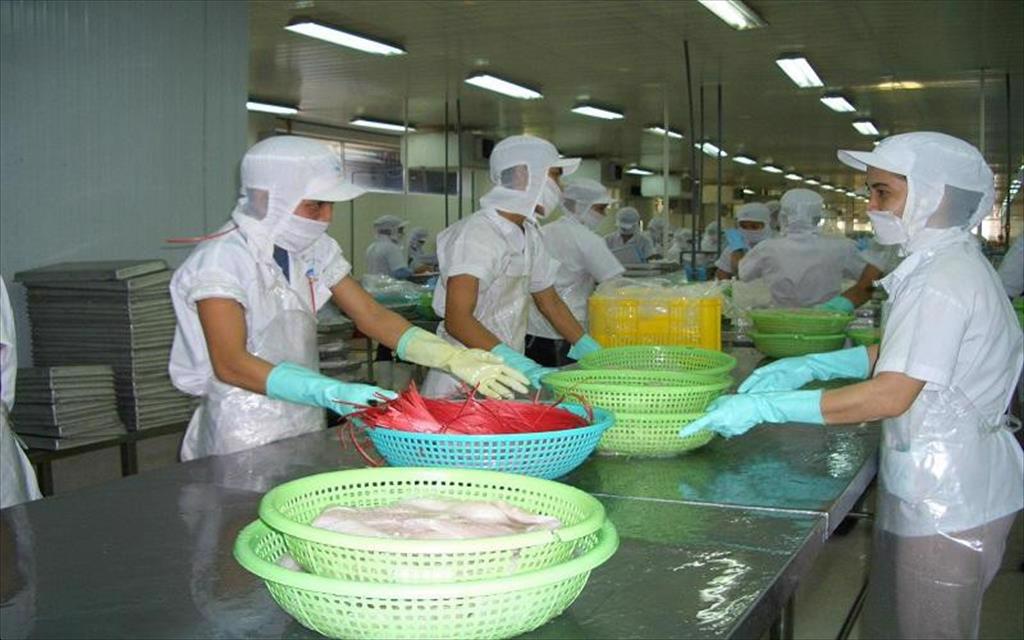(seafood.vasep.com.vn) China is still a large importing market for Vietnamese seafood, but the recovery forecasts for 2022 are not enough to make a statement of growth with certainty.
 Exports to China surged but had not returned to pre-Covid norms - Source: BizLive
Exports to China surged but had not returned to pre-Covid norms - Source: BizLive
According to preliminary statistics of the General Department of Customs, in February 2022, seafood exports reached US$637,839, down 26.9% from the previous month. For two months cumulatively, seafood exports reached US$1,507 billion, up 50.2% from the same period in 2021.
Shrimp exports to China dropped sharply...
According to the Vietnam Association of Seafood Exporters and Producers (VASEP), from January 1 to February 15, seafood exports reached US$1.074 billion, up 34.2% from the same period last year.
In which shrimp exports reached US$385.422 million, up 31.7% from the same period, exports to the Chinese market alone reached US$22,983 million, down 7.45% from the same period last year.
By volume, China is Vietnam's sixth largest shrimp import market, accounting for 6%, but in terms of individual markets, China ranks 26th out of 63 shrimp import markets of Vietnam.
Although shrimp export turnover to China is declining, VASEP expects shrimp exports to this market to recover this year after a decline last year.
According to Ms. Kim Thu - VASEP expert, as of February 15, 2022, shrimp exports to China reached nearly US$23 million, down 7.4% from the same period last year. Although exports did not increase at the beginning of the year, the rate of decline was lower than the previous year's decline. Shrimp exports to China this year are expected to recover as the country begins to relax strict import controls.
In 2022, China's shrimp imports are forecasted to increase sharply, especially when a primary shrimp supplier to China, Ecuador, is planning to regain market share in this market after a decline in 2020 and 2021 due to detected coronavirus on product packaging.
… challenges all the way
Vietnam is the fourth largest shrimp supplier to the Chinese market, following Ecuador, India, and Thailand.
Although the decline in shrimp exports to the Chinese market has been slight compared to before, China's regulations and barriers are still stringent, especially at a time when China's customs authorities tighten supervision of imported food products during the COVID-19 pandemic.
The biggest problem is that Vietnamese shrimp exporters need to strictly control hygiene and sterilization standards, especially during the loading and unloading stage, to minimize shipments that may be flagged as being COVID-19-related.
In 2021, China strictly controlled imports due to the impact of the COVID-19 pandemic. They also suspended the imports of many companies in India, Ecuador, and Asia, and reversed to boost consumption of domestically produced seafood instead of imported goods.
Moreover, China's pursuit of the "Zero Covid" policy, which stipulates strict control of the COVID-19 pandemic at China's import ports by air, sea, and border, has created many difficulties for Vietnamese exports shrimp last year.
Pangasius exports to China increased dramatically in volume
According to VASEP, from January 1 to February 15, Vietnam's pangasius export turnover to all markets reached US$272,717 million, up 70.8% over the same period last year, of which exports to markets China (behind the US) reached US$51,181 million, up 277.5% over the same period.
Commenting on this massive increase, Mr. Truong Dinh Hoe - General Secretary of VASEP, said that pangasius exports to China increased dramatically. Still, the absolute value did not improve and did not return to the pre-Covid level.
Due to the "Zero Covid" policy of the Chinese Government, the customs of this country continuously and rigorously inspect imported goods, causing the release of goods to be deferred. When detecting Coronavirus on the packaging of imported goods, they did not allow the shipment in.
Now that the pandemic situation has loosened and the demand is recovering, there has been high growth in exports; but in terms of absolute value, it has not increased much and is still lower than usual, there are 03 reasons affecting this market:
Firstly, the "Zero covid" policy of the Chinese Government caused seafood exports from Vietnam to China to decrease sharply in late 2021, bounce back in early 2022 due to increased demand but still limited.
Second, China is increasing imports but the government is still concerned about the COVID-19 pandemic.
“In the past, China imported seafood from many countries, and when discovering that SARS-CoV-2 was present on imported seafood packaging, they attributed it to the presence of Coronavirus in imported goods, so consumption was reduced, causing restaurants to also reduce demand for imported seafood products because the procedure was too complicated. That is also a reason for the low volume of exports to China”, emphasized VASEP Secretary-General.
Third, China's border seafood trade last year also dropped sharply.
Commenting on the seafood import demand of the Chinese market, VASEP Secretary-General said that China is still pinpointed as a good market.
“The world is starting to hope for a brighter future and the pandemic may be over this year, so food consumption needs and food trade will be a matter of priority and seafood exports will observe a growth, and the outlook for the Chinese market will also be much better than in 2021.
However, up to now, VASEP has not been able to make a forecast of export turnover in 2022, because it takes a certain time horizon to observe the market’s growth trend. But in 2022, seafood exports will undoubtedly increase more than in 2021 because there are more favorable factors", VASEP Secretary-General affirmed.
Source: BizLive